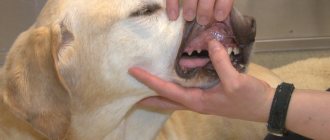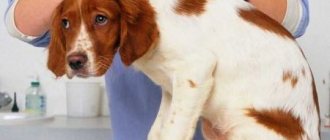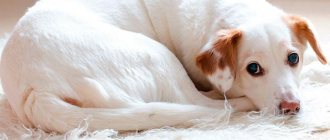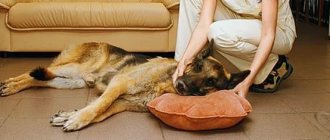The structure of the respiratory system of animals
There are practically no special differences from the respiratory systems of other mammals. The composition includes organs:
- upper respiratory tract;
- lower respiratory tract.
The top paths are:
- The dog's nose, which is needed to detect odors, communicates with parts of the brain. And the part that captures odors contains sensory cells. In addition, the nose warms cold air in winter, which prevents it from entering the lungs.
- The pharynx can be divided into the nasopharynx and the lower part. The nasopharynx contains ligaments that help the mammal make sounds.
- The trachea is a kind of air duct, here the air is additionally warmed and moistened. The trachea is supported by special cartilage and muscles that support it and help it stretch.
Location of organs in a dog
Lower respiratory tract:
- Bronchi are parts of branching tracheas, and they themselves are divided into bronchioles, at the ends of which there are alveoli (similar to vesicles).
- The lungs consist of several million alveoli, they are surrounded by blood capillaries. The walls of the alveoli consist of only one cell, which allows for intensive exchange of oxygen between the capillaries and alveoli.
Lower respiratory tract of a dog
The body's protection of the respiratory system
Protection against hypothermia of a dog’s lungs is a function of the internal surfaces of the respiratory organs; in addition, the external tissues of these organs include microcilia, which remove all excess that comes from the outside.
The work of eyelashes is sometimes disrupted, which may be due to:
- infectious diseases;
- irritating factors;
- animal injury;
- inflammation for various reasons.
As a result, the dog begins to sneeze and cough. It is better to consider the possible reasons in order, from the simplest.
Allergic reactions and others not related to diseases
Perhaps the dog reacts to new smells in the house or garden in this way:
- new hostess/host perfume/cologne;
- another animal appeared, for example, a cat;
- too dusty room;
- smoke from smoldering tobacco;
- flowers.
Cigarette smoke can cause your dog to sneeze
It should be noted that in addition to sneezing, other reactions should also manifest themselves, for example:
- redness of the eyes;
- swelling of the nose;
- dog scratching (itching);
- possible loss of some hair;
- discharge of mucus from the nose.
It doesn't have to be all together, but something other than a sneeze should show up.
You can determine what exactly an animal reacts to by simply observing it. For example, if after playing with a domestic cat the dog’s behavior clearly changes, it begins to sneeze and itch, then the culprit is apparently the cat. Although this rarely happens.
Just like humans, dogs can be allergic to cats.
A dog has a very sensitive sense of smell, so those aromas that are quite normal for the owner can be unbearable for the pet - overly odorous perfumes and flowers, for example.
It is also worth noting that a dog, being constantly near the floor, can react in this way to dust in the house while sneezing.
If the creators of the breed intended a flattened nose for the animal, then such pets will have more problems with breathing and sneezing, compared to “classically” nosed dogs.
A piece of lint or an insect that gets into your nose can also confuse you. Therefore, you should not immediately panic if your animal suddenly sneezes several times. It is quite possible that after 3-4 minutes the foreign body will come out on its own.
Allergic reactions, if their cause could not be independently discovered, can be diagnosed by a veterinarian.
Manifestation of allergies on animal skin
When it is already known for certain that a dog is allergic, it is not recommended to bring other furry animals into the house. If a dog reacts poorly to one allergen, then it is likely that the reaction will be similar to another.
In any case, you should first make sure that the animals can have normal contact with each other.
In some cases, measures such as weekly bathing of the cat help, especially if it suffers from dandruff (this is what can cause allergies in a dog), removing excess hair by combing with special combs, vacuuming, and using air purifiers.
First aid for nosebleeds in dogs
If suddenly your dog suddenly starts bleeding from the nose, the first thing you should do is suppress panic and calm down.
. In a state of nervousness, it will not be possible to help the animal. You will also need to calm down the pet itself, since during times of nervousness and severe fright, its blood pressure may rise even more, which will worsen the situation.
As the pressure increases, the blood will flow more often and it will be very difficult to stop it. But giving any type of dog sedatives is strictly prohibited unless consultation with a veterinarian has been obtained. Without establishing the cause of bleeding, such substances can have a detrimental effect on the condition of the animal as a whole and have undesirable consequences.
After the dog has calmed down, place a cloth soaked in cold water or a bag containing ice on his nose. This must be done so that the blood vessels narrow and blood flow decreases. If this does not happen, and, in addition to everything, the dog begins to experience heavy breathing, you urgently need to call an ambulance, or carefully take the animal to a veterinary clinic.
As the blood flows, you should examine the dog’s face in order to understand, at least by external signs, what caused the bleeding. When examining, you need to pay attention to whether there is swelling, swelling, or any changes in skin color on the back of the dog’s nose. It is also important to note whether there are accompanying signs such as lacrimation and redness of the third eyelid.
In addition to examining the dog’s face, it is worth paying attention to the presence of blood in the animal’s mouth, the color of its stool, since if there is bleeding in the intestines, it is black, and the presence of gag reflexes, since such a sign indicates bleeding in the stomach.
To make a more accurate diagnosis, there is a need to scroll through the following points in memory:
- Is there rat poison in the house or area where the dog roams?
- Are there any thorny plants growing that can injure the dog?
- Have there been conflict situations between the pet and other dogs that could lead to a fight?
- What kind of drugs has the animal used recently?
Sneezing with blood
If your dog's nose bleeds when he sneezes, you should try to stop the bleeding and consult a doctor immediately.
If your dog has a nosebleed, you should consult a doctor immediately.
Advice! If a dog's mucous membranes turn pale, it should be taken without waiting in line at the veterinary hospital, as there is a risk of blood loss.
You can try to stop the bleeding by applying something cold to your nose. Ice, wet rag. Do not remove clotted blood to prevent bleeding from happening again.
You can stop the bleeding by applying something cold to the back of your dog's nose.
Sometimes during play the animal may get a slight injury to its nose; this will also often be accompanied by sneezing and bleeding. In order to exclude fractures, it is better to consult a doctor.
Among the foreign objects that are sometimes found in the animal's nostrils there may be parasites (for example, helminths).
An additional symptom that can be observed is scratching the butt, trying to “ride” it on the carpet or floor. To combat helminths, appropriate medications are prescribed.
Causes of sneezing in dogs
Sneezing in a dog can cause:
- Hypothermia of the body.
- Rhinitis.
- Infection.
- Allergy.
- Injury.
- Heart diseases.
- Foreign body.
If your dog sneezes during a walk, do not rush to sound the alarm; single sneezes are quite acceptable. Everyone knows that a dog smells everything, as a result of which dust, earth, seeds or pollen, etc. often end up in the dog’s nose. If a dog’s sneezing becomes frequent and other symptoms are added, the dog’s owner will need to figure out why the dog is sneezing, whether there is any disease, and whether it is worth taking the dog to a veterinary clinic.
Infections
Attention! It should be noted that if there is a suspicion of an infectious disease, it is recommended not to self-medicate, but to immediately go to a veterinary clinic.
If you suspect an infection, a visit to the veterinarian is mandatory!
Additional symptoms observed include sour eyes and coughing, while the dog appears lethargic, does not show signs of joy, eats little or refuses food altogether. Drinks a lot of fluids. Sometimes the dog starts vomiting.
Some diseases accompanied by a runny nose:
- tracheobronchitis;
- adenoviral hepatitis.
Advice! A good prevention of such diseases is to maintain good immunity of the pet. To do this, you should provide the dog with proper nutrition with the necessary daily vitamins and other nutrients. It is also desirable that the dog leads an active lifestyle.
Balanced feeding of dogs is the key to a healthy and long life for your pet.
Be sure to get all necessary vaccinations in advance. Some vaccinations are given several times throughout life.
Polyps in the nasal cavity
Polyps are foreign formations that are removed by surgeons. Sometimes they may appear again. Therefore, it is recommended to carry out preventive examinations with a veterinarian after surgery. If the tumor is not benign, the doctor’s prognosis may be unfavorable; sometimes radiation is performed.
Nasal polyps in a dog
Causes of bleeding
It manifests itself in two forms: acute (abundantly, unexpectedly) and chronic (sparsely, for a long time). The common cause can be identified by location. If the discharge is from one nostril, then the cause is traumatic, if one of the two is a pathology of systems, organs or the whole organism. Causes:
- Mechanical damage. The occurrence factors are a blunt blow to the nose or a fall from a height. As a result, the soft and bone tissue of the head is injured, and the integrity of the blood vessels is disrupted. Additional symptoms are swelling, abrasions, redness. Danger: internal bleeding.
- Heatstroke. Develops as a result of prolonged exposure to the sun or in an unventilated area. Serious consequences - coma or death.
- Age-related changes. With the onset of old age, there is an increase in intracranial pressure and a gradual thinning of blood vessels.
- Poisoning. A dog's nosebleed is a symptom that occurs due to intoxication with rat poisons. Their effect is a violation of the integrity of blood vessels, a decrease in coagulability.
- Cancerous tumors. They come in different etiologies. As they develop, they increase in size and compress the vessels in the nasal cavity.
- Exposure to foreign objects. For example, the nasal passages can be damaged due to injury from hard spikelets of early grass in early summer. Along with bleeding, swelling and abscess occur.
- Disturbances in the functioning of the endocrine system. For example, an overactive thyroid or adrenal gland often causes bleeding. A common disease is Cushing's syndrome.
- Diseases of an infectious nature. They can be caused by bacteria, viruses or fungi.
- Heredity. The diseases are associated with blood clotting disorders.
- Kidney failure. Symptoms are hypertension, which leads to damage and rupture of blood vessels, weakness, loss of appetite.
- Allergic reaction to medications.
- Vitamin K deficiency. Leads to microtrauma of the capillaries, the network of which is located in the nasal cavity.
Additional symptoms
A dog's nose bleeds is sometimes accompanied by more serious symptoms:
- Bloody urine and black stool are signs of internal bleeding.
- Sneezing with blood is a symptom of hemophilia or prolonged bleeding.
- Dullness of the mucous membranes is a sign of intense blood loss.
- Strained breathing, lack of reaction - anemia, heat stroke.
- Jaundice – disturbances in liver function.
- Swelling of the nose or head.
With these symptoms, the pet’s life is in danger, so immediate assistance is required.
Runny nose. Cold
The dog sneezes and produces mucus. This probably occurred as a result of prolonged hypothermia of the animal. Most often, indoor and short-haired breeds of dogs that are only occasionally outdoors are susceptible to these ailments - 2-3 times a day.
Service species have a thick undercoat and are able to calmly respond to low temperatures.
You can distinguish a cold from other diseases by the duration of sneezing (it lasts a day or more), plus:
- lethargic state;
- cough;
- swelling of the eyes.
If the dog behaves normally and eats well, then there is no reason to worry even about small discharge and sneezing; most likely, the dog’s body will cope with a minor illness on its own.
To prevent colds, it is recommended to reduce the duration of walks during the cold season. It is better to increase their number, for example, from two to three.
For short-haired dogs, you can purchase warm overalls (or sew them yourself).
Warm overalls will save your dog from hypothermia in the cold season
You should also not feed or water your dog with cold foods (ice cream and others) or water, especially in hot weather. After bathing your dog, you should dry it thoroughly.
Video - Runny nose and colds in dogs
Main causes of sneezing
Why does a dog sneeze often? The reasons may be different. The following are considered the main ones:
- first of all, a cold or rhinitis;
- allergic reaction;
- the presence of a foreign body in the nasal cavity;
- animal disease;
- injury;
- presence of heart problems;
- infection.
If your dog starts sneezing, don’t immediately panic and take it to the veterinary clinic. The pet itself will tell you what to do. The animal is constantly sniffing something; pollen, dust, earth, etc. could get into its nose. This is not a reason to take your pet to see a doctor. We need to figure out how often this happens, when, under what conditions, and what other symptoms it is accompanied by.
How to examine a dog. Temperature measurement
If the owner notices frequently repeated sneezing and grunting in the dog, yellow and greenish discharge from the nasal ducts, and strange behavior, the dog needs to be examined.
If you suspect that there is something foreign in the nasal cavity or inflammation, you should carefully shine a flashlight and inspect the nasal passages. Be sure to feel the nose; in a healthy dog it should be wet and cold.
Instructions on how to take a dog's temperature
Advice! You should make sure that the animal did not doze before the examination, was not in the sun in the heat, or played actively - in these cases the nose also becomes dry.
The gums of a healthy dog should not be dry or warm (such signs may indicate infection with a virus).
The normal appearance of the mucous membranes is approximately the same as in humans: uniform in color, shiny, moist.
If a dog has a fever, the owner will feel it throughout the body. You should feel the dog’s body in different places.
Attention! At high temperatures, the dog drinks approximately 2-2.5 times more liquid, which will be immediately noticeable.
Causes
There are several causes of nosebleeds in dogs.
- Injuries. Bleeding from the nostrils may occur after trauma to the nasal cavity.
- Surgical intervention.
- Inflammation in the nasal passages.
- Development and growth of tumors.
- Poor blood clotting.
- Problems with the dental cavity (tooth abscess, etc.).
Bloody discharge from the nose can most often be noticed during sneezing or the constant release of a small stream or a few drops of blood.
How you can help your dog
If your dog is sneezing due to a foreign object getting into its nose, and this was discovered during examination, you can try to remove it yourself. You may need to ask someone to hold the dog. Using narrow tweezers, you can remove the object from your pet's nose.
You can remove a foreign object from a dog’s nose yourself only if it is nearby
How to relieve a simple runny nose:
- If breathing is impaired, you can remove the discharge with cotton swabs, moistening them in warm water.
- If a crust has formed on the nose, it is removed using chamomile infusion, soaking the problem areas. To prevent crusts from appearing again, you need to anoint the skin with Vaseline.
- Sometimes ordinary nasal drops help, but only with herbal contents (Pinosol).
- If the pet also has a cough, some owners successfully drink warm milk and honey to soften the throat.
- Doctors advise adding vitamins A and E to your dog’s food.
It should be noted that with a “stuffy” nose, it will be easier for the dog to eat liquid, warm food.
Other cases will require the participation of a qualified physician. Especially with fever, refusal to eat, or fainting.
Video - About a runny nose in a dog
Why does a dog sneeze
Sneezing in a dog can be caused by many reasons, both completely harmless and posing a danger to the health and even the life of your four-legged pet.
The most common causes of prolonged sneezing in dogs are:
- infectious diseases;
- allergic reactions;
- cardiovascular diseases;
- injuries;
- the presence of foreign bodies in the nasal cavity;
- development of neoplasms in the nasal sinuses;
- hypothermia.
If your furry friend sneezed only 1 or 2 times, there is no need to worry about this, but if the sneezing is accompanied by other symptoms, such as refusal to eat, lethargy, or blood from the nasal passages, the dog should be seen by a specialist immediately.
Infectious diseases
Viral infections are often the cause of sneezing. A sick dog, in addition to frequent sneezing, also suffers from lack of appetite, increased thirst, discharge from the nose and eyes, wheezing and coughing (with diseases of the bronchi and lungs).
If a viral disease affects the animal's gastrointestinal tract, the dog will experience vomiting and diarrhea containing mucus, blood and a strong, unpleasant odor.
Fungal infections are usually not accompanied by such striking symptoms, since they often take a chronic form and occur with symptoms such as conjunctivitis, runny nose, and fever.
Allergy
A dog's nose is the main organ that allows the animal to explore the outside world. Dogs inhale various substances through their nose, which can cause an allergic reaction and frequent sneezing:
- chemicals (household chemicals, perfumes, etc.);
- flower pollen;
- dirt and dust;
- cigarette smoke;
- mold.
In addition, the development of allergies is facilitated by the bites of various insects, feeding the animal with certain foods, wearing flea collars, and the use of medications.
Symptoms of an allergic reaction include: lacrimation and runny nose, cough, difficulty breathing, rashes and itching on the skin, hair loss.
Heart diseases
Cardiovascular disease is not uncommon in older animals. Diseases of the main muscle of the body can be complications after suffering stress, viral infections, or severe physical exertion.
Symptoms of heart disease include coughing, wheezing, and frequent sneezing.
Injuries and foreign bodies in the nasal passages
Dogs are very active creatures, constantly on the move. Often, during games, various foreign objects (plant particles, small twigs, specks) get into the animal’s nose.
Sensing a foreign body in the nose, the animal begins to sneeze and snort intensely, thereby trying to clear the nasal sinuses of the irritant. In most cases, this phenomenon is completely harmless and the foreign object comes out of the nose on its own. But if, when your pet sneezes, mucus mixed with blood flows from the nose, this may indicate damage and even injury to the mucous membrane.
Neoplasms
Tumors and polyps in the nose almost always cause constant sneezing in a dog. An attentive owner will always notice the appearance of strange symptoms, such as blood or tissue particles (due to a decaying tumor), shaking the head, or rubbing the muzzle on the furniture. In addition, the animal exhibits whistling, wheezing, grunting, and difficulty breathing.
Hypothermia
With a sharp change in temperature, a dog often experiences sneezing, as the blood vessels in the nasal cavity expand or, conversely, narrow. This phenomenon can be observed, for example, when an animal enters a warm room after a cold street. To prevent the animal from catching a cold, it must be warmed during walks using special overalls for dogs.
With severe hypothermia, the dog often sneezes, coughs, and trembles from the cold. An increase in body temperature often occurs; with frostbite, blisters may appear on the skin and pale mucous membranes.
Various real cases
Anna: “I am the owner of a Yorkshire terrier named Alex. I was faced with the problem of snot and sneezing. The reason for this was an allergic reaction to the new food. We changed the food and everything went away.”
V. Titaev (expert on hunting huskies). “I cured my dog of a cold without any medications. She was mated, so the veterinarian advised the following:
- a tablespoon of honey;
- a spoonful of grated (finely chopped) garlic;
- 2 heaped tablespoons of flour.
Mix and roll out like a sausage. Cut into 3 parts. We give it 3 times a day. Move the dog to a warm room.
She was completely cured and gave birth to puppies without any problems.”











